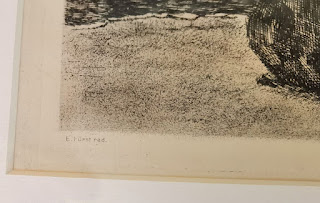Georg Jahn (1869 - 1940) The Artist in his Studio
------------------------------------------------
Over the holidays I was doing my usual rambling around the halls of eBay Deutschland when I happened upon an intaglio print by Georg Jahn (1869 - 1940) titled "Pferdeschwemme," signed and dated 1921. I had a flashback to the first time I viewed this print in a museum sometime during my 10 years in New York City many moons ago. It's the kind of artwork that makes a definite impression because of the skill of the master graphic artist who created it. The asking price somewhat stretched the budget but I made the decision to bring it into my collection, that's how much I admired the print. There are apparently two versions of this print created at two different times in the artist's work life. The first edition of the print is titled "Junge Reiter am Wasser" (Young Riders by the Lake) and was created in 1909 by Georg Jahn. The second edition (dated 1921) was titled "Pferdeschemme" and is the particular print now in my collection. Here are illustrations of the two editions that my research on past auction results could find:
Second Edition titled: "Pferdeschemme," signed and dated 1921.
The Print is quite large at 22 inches by 18 inches.
-------------------------------------------
As you can see the artist has made changes in the background of the composition on the middle right hand side.
Here is some biographic information on the artist:
German artist Georg Jahn was one of the greatest etchers to hail from the Dresden region. His works, produced during the early 20th century, are impeccable examples of the delicate and skilful art of etching, as well as being indicative of the tensions arising in German art during this time between the classical and the modern.
Jahn’s artistic career began with a job in the Meissen Porcelain Factory, painting with painstaking detail the minuscule decoration upon the ceramics. He surely showed incredible skill, for his works earnt him a scholarship to study at the Dresden Academy of Fine Arts. Jahn would begin his artistic education there, under renowned portrait painter Leon Pohle (1841-1908), before moving on to complete his studies at the Grand-Ducal Saxon Art School, under Max Thedy (1858-1924).
Perhaps both of these teachers bore an influence, for Jahn would christen his professional painting career with a tenure as a portrait painter himself, working in Berlin, Munich, and Leipzig. However, at this time he began to find an interest in etching and took lessons from his friend, Max Pietschmann. Soon enough, Jahn was fluent in all styles of etching. The seeds of artistic greatness had been sown, and from the soil began to bloom Jahn’s true artistic calling.
Etching has a strong connection with Germany. It was within the Germanic lands the medium first began to be developed. During Jahn’s time, it was becoming as much influenced by modern developments in art as any other medium. Indeed, Jahn became swept up in the tensions being wrought through the Dresden art scene between the traditional, classical school of art, and the modern, experimental avant-garde. Jahn himself settled more comfortably on the side of the modern pioneers, exhibiting numerous times with the Dresden Secession, an art group established in protest of the classical leanings of the art institutions. However, his art style found much more of a middle ground between both the classical and the modern.
Jahn paints with elegance and coherency of form much more aligned with the classical, traditional style. His nude women, who he so often depicted, are gloriously rendered. Their black and white presentation makes them appear as if marble statues, captured on paper. Yet he places them within freer, natural settings of lakes and rivers, beaches and bays. This was very much in tune with the ideology of Art Nouveau, which was interested in raw, expressive depictions of the natural world.
Jahn’s settings are so very often natural, and he utilises his accomplished skill to strike out across the page the many nooks and crannies of nature’s visage. Each tree branch ragged, each rockface cragged. Jahn was keen on depicting studies of everyday life, marrying nature’s beauty with his accomplished talent.
This carried forwards into his compositions. Jahn was uninterested in puzzling allegories which might keep the viewer guessing as to the meaning and message of his works. He offered up pieces with a clarity of form and communication.
Human subjects are set within their surroundings and connected in a harmony of composition which enables the viewer to read the scene clearly. Fishermen in the foreground lie along the same line of the canvas as the horizon of the sea to which they dedicate their days. A group of girls, knitting and nattering, are balanced neatly upon the paper with their hometown, both symbols of domestic, everyday life.
There is a simplicity to the storytelling in his works which does not squander their artistic value or sophistication. This composition joined with Jahn’s extremely evocative knack for depicting both human emotion and the flushes and rushes of nature, creates works both discerning and energised.
Jahn was much celebrated in his lifetime. His works were regularly exhibited within his homeland, and he won numerous awards, including a Saxon State Medal. He left approximately 300 works following his death in 1940. History has been a tough force against which Jahn’s memory has reckoned, however his work and his influence have been rediscovered and newly celebrated. Many today consider him one of the greatest German etchers of the 20th century.
----------------------------
And here are some additional illustrations of the print:
---------------------------------------------
Here are examples of his other works:

























%20-%20(MeisterDrucke-366141).jpg)




















